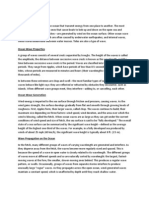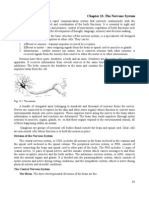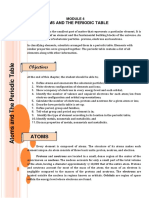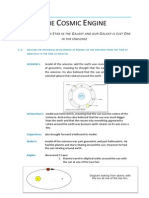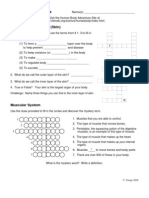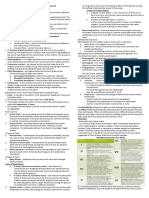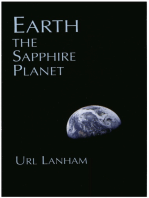Matter:: Chemistry Is The Science of Matter and The Changes It Undergoes. The Science of Matter Is Also
Matter:: Chemistry Is The Science of Matter and The Changes It Undergoes. The Science of Matter Is Also
Uploaded by
Ridwan KingdomCopyright:
Available Formats
Matter:: Chemistry Is The Science of Matter and The Changes It Undergoes. The Science of Matter Is Also
Matter:: Chemistry Is The Science of Matter and The Changes It Undergoes. The Science of Matter Is Also
Uploaded by
Ridwan KingdomOriginal Description:
Original Title
Copyright
Available Formats
Share this document
Did you find this document useful?
Is this content inappropriate?
Copyright:
Available Formats
Matter:: Chemistry Is The Science of Matter and The Changes It Undergoes. The Science of Matter Is Also
Matter:: Chemistry Is The Science of Matter and The Changes It Undergoes. The Science of Matter Is Also
Uploaded by
Ridwan KingdomCopyright:
Available Formats
Chemistry is the science of matter and the changes it undergoes.
The science of matter is also addressed by physics, but while physics takes a more general and fundamental approach, chemistry is more specialized, being concerned with the composition, behavior, structure, and properties of matter, as well as the changes it undergoes during chemical reactions. Chemistry is the study of interactions of chemical substances (a chemical substance is a material with a specific chemical composition. A common example of a chemical substance is pure water; it has the same properties and the same ratio of hydrogen to oxygen whether it is isolated from a river or made in a laboratory) with one another and energy.
Disciplines within chemistry are traditionally grouped by the type of matter being studied or the kind of study. These include inorganic chemistry, the study of inorganic matter; organic chemistry, the study of organic (carbon based) matter; biochemistry, the study of substances found in biological organisms; physical chemistry, the study of chemical processes using physical concepts such as thermodynamics and quantum mechanics; and analytical chemistry, the analysis of material samples to gain an understanding of their chemical composition and structure.
Matter:
Matter is everything around us. Matter is anything made of atoms and molecules. Matter is anything that has a mass. Matter is also related to light and electromagnetic radiation. Even though matter can be found all over the universe, we usually find it in just a few forms. As of 1995, scientists have identified five states of matter. We know about solids, liquids, gases, plasmas, and a new one called Bose-Einstein condensates. The first four have been around a long time. The scientists who worked with the Bose-Einstein condensate received a Nobel Prize for their work in 1995. But what makes a state of matter? It's about the physical state of molecules and atoms.
Solid
Solids are usually hard because their molecules have been packed together. The closer your molecules are, the harder you are. Solids also can hold their own shape. A rock will always look like a rock unless something happens to it. The same goes for a diamond. Even when you grind up a solid into a powder, you will see little tiny pieces of that solid under a microscope. Liquids will move and fill up any container. Solids like their shape. In the same way that a solid holds its shape, the atoms inside of a solid are not allowed to move around too much. This is one of the physical characteristics of solids.
Liquid:
Liquid is one of the three classical states of matter. Like a gas, a liquid is able to flow and take the shape of a container, but, like a solid, it resists compression. Unlike a gas, a liquid does not disperse to fill every
space of a container, and maintains a fairly constant density. Structure of a classical monatomic liquid atoms have many nearest neighbors in contact, yet no long-range order is present.
Gas:
Gas is everywhere. There is something called the atmosphere. That's a big layer of gas that surrounds the Earth. Gases are random groups of atoms. In solids, atoms and molecules are compact and close together. Liquids have atoms a little more spread out. However, gases are really spread out and the atoms and molecules are full of energy. They are bouncing around constantly. Gases can fill a container of any size or shape. That is one of their physical characteristics. Think about a balloon. No matter what shape you make the balloon it will be evenly filled with the gas atoms. The atoms and molecules are spread equally throughout the entire balloon. Liquids can only fill the bottom of the container while gases can fill it entirely
Changing States of Matter
All matter can move from one state to another. It may require very low temperatures or very high pressures, but it can be done. Phase changes happen when certain points are reached. Sometimes a liquid wants to become a solid. Scientists use something called a freezing point to measure when that liquid turns into a solid. There are physical effects that can change the freezing point. Pressure is one of those effects. When the pressure surrounding a substance goes up, the freezing point also goes up. That means it's easier to freeze the substance at higher pressures. When it gets colder, most solids shrink in size. There are a few which expand but most shrink. Now you're a solid. You're a cube of ice sitting on a counter. You dream of becoming liquid water. You need some energy. Atoms in a liquid have more energy than the atoms in a solid. The easiest energy
around is probably heat. There is a magic temperature for every substance called the melting point. When a solid reaches the temperature of its melting point it can become a liquid. For water the temperature has to be a little over zero degrees Celsius. If you were salt, sugar, or wood your melting point would be higher than water. The reverse is true if you are a gas. You need to lose some energy from your very excited gas atoms. The easy answer is to lower the surrounding temperature. When the temperature drops, energy will be sucked out of your gas atoms. When you reach the temperature of the condensation point, you become a liquid. If you were the steam of a boiling pot of water and you hit the wall, the wall would be so cool that you would quickly become a liquid. Finally, you're a gas. They are too cool!" You're already halfway there being a gas. You still need to tear off a bunch of electrons from your atoms. Eventually you'll have bunches of positively and negatively charged particles in almost equal concentrations. When the ions are in equal amounts, the charge of the entire plasma is close to neutral. (A whole bunch of positive particles will cancel out the charge of an equal bunch of negatively charged particles.) A plasma can be made from a gas if a lot of energy is pushed inside. All of this extra energy makes the neutral atoms break apart into positively and negatively charged ions and free electrons. They wind up in a big gaseous ball.
Atoms
If we want to have a language, we will need an alphabet. Other examples in chemistry are not any different. If you want to build molecules, you will need elements. Each element is a little bit different from the rest. Those elements are the alphabet to the language of molecules. Let's stretch the idea a bit. If we read a book, we will read a language. Letters make up that language. But what makes those letters possible? Ummm... Ink? Yes! we need ink to crate the letters. And for each letter, it is the same type of ink. Elements are like those letters. They have something in common. That's where atoms come in. All elements are made of atoms. While the atoms may have different weights and organization, they are all built in the same way. Electrons, protons, and neutrons make the universe go. An atom is the basic unit of chemistry. It consists of a positively charged core (the atomic nucleus) which contains protons and
neutrons, and which maintains a number of electrons to balance the positive charge in the nucleus. The atomic nucleus contains a mix of positively charged protons and electrically neutral neutrons (except in the case of hydrogen, which is the only stable nuclide with no neutrons). The electrons of an atom are bound to the nucleus by the electromagnetic force. Likewise, a group of atoms can remain bound to each other, forming a molecule. An atom containing an equal number of protons and electrons is electrically neutral; otherwise it has a positive or negative charge and is an ion. An atom is classified according to the number of protons and neutrons in its nucleus: the number of protons determines the chemical element, and the number of neutrons determines the isotope of the element.
Atomic Number:
The atomic number (also known as the proton number) is the number of protons found in the nucleus of an atom and therefore identical to the charge number of the nucleus. It is conventionally represented by the symbol Z. The atomic number uniquely identifies a chemical element. In an atom of neutral charge, the atomic number is also equal to the number of electrons.
Element:
The concept of chemical element is related to that of chemical substance. A chemical element is specifically a substance which is composed of a single type of atom. A chemical element is characterized by a particular number of protons in the nuclei of its atoms. This number is known as the atomic number of the element. For example, all atoms with 6 protons in their nuclei are atoms of the chemical element carbon, and all atoms with 92 protons in their nuclei are atoms of the element uranium. 94 different chemical elements or types of atoms based on the number of protons exist naturally. A further 18 have been recognized by IUPAC (International Union of Pure and Applied Chemistry) as existing artificially only. The most convenient presentation of the chemical elements is in the periodic table of the chemical elements, which groups elements by atomic number. Due to its ingenious arrangement, groups, or columns, and periods, or rows, of elements in the table either share several chemical properties, or follow a certain trend in characteristics such as atomic radius, electro negativity, etc. Lists of the elements by name, by symbol, and by atomic number are also available.
Substance
A chemical substance is a kind of matter with a definite composition and set of properties. Strictly speaking, a mixture of compounds, elements or compounds and elements is not a chemical substance, but it may be called a chemical. Most of the substances we encounter in our daily life are some kind of mixture; for example: air, alloys, biomass, etc. Nomenclature of substances is a critical part of the language of chemistry. Generally it refers to a system for naming chemical compounds. Earlier in the history of chemistry substances were given name by their discoverer, which often led to some confusion and difficulty. However, today the IUPAC system of
chemical nomenclature allows chemists to specify by name specific compounds amongst the vast variety of possible chemicals. The standard nomenclature of chemical substances is set by the International Union of Pure and Applied Chemistry (IUPAC). There are well-defined systems in place for naming chemical species. Organic compounds are named according to the organic nomenclature system. Inorganic compounds are named according to the inorganic nomenclature system. In addition the Chemical Abstracts Service has devised a method to index chemical substance. In this scheme each chemical substance is identifiable by a number known as CAS registry number.
You might also like
- The Radioactive Boy ScoutDocument15 pagesThe Radioactive Boy ScoutPixelate100% (2)
- Pacing Guide For Grade 9 (2022-2023)Document11 pagesPacing Guide For Grade 9 (2022-2023)israa.mahmoud.egNo ratings yet
- Radiometric Dating Lab: ProblemDocument5 pagesRadiometric Dating Lab: ProblemApril Mae ArcayaNo ratings yet
- Level Past Paper Questions - Physics O: TOPIC-23 Radioactivity PAPER-1 Multiple ChoiceDocument17 pagesLevel Past Paper Questions - Physics O: TOPIC-23 Radioactivity PAPER-1 Multiple Choiceelty TanNo ratings yet
- Chemistry NotesDocument9 pagesChemistry NotesAyesha MuftiNo ratings yet
- Physical Science Notes-1Document216 pagesPhysical Science Notes-1Yaj CruzadaNo ratings yet
- Organic Chemistry NotesDocument21 pagesOrganic Chemistry NotesBobbyWhiteNo ratings yet
- 02 Scalar and Vector QuantityDocument2 pages02 Scalar and Vector QuantityChrisshalyn Sy PinedaNo ratings yet
- Types of Marine OrganismsDocument10 pagesTypes of Marine OrganismsHira AnwarNo ratings yet
- Ocean Wave RefractionDocument5 pagesOcean Wave RefractionSifiso NdabaNo ratings yet
- Physical ScienceDocument10 pagesPhysical ScienceGeoffrey MilesNo ratings yet
- Relationships Between Theory by RevisionworldDocument2 pagesRelationships Between Theory by RevisionworldmohsinNo ratings yet
- Cycling of Materials in EcosystemsDocument25 pagesCycling of Materials in EcosystemsAyesha SarwarNo ratings yet
- Lecture notes-XII-Sexual Reproduction in Flowering PlantsDocument11 pagesLecture notes-XII-Sexual Reproduction in Flowering Plantsaditya100% (3)
- Zoology Notes: 017 Chapter 13Document3 pagesZoology Notes: 017 Chapter 13humanupgrade100% (1)
- 2010-03!30!134914 Multicultural Education NotesDocument3 pages2010-03!30!134914 Multicultural Education NotesLary BagsNo ratings yet
- HEREDITY AND VARIATION Grade 10Document111 pagesHEREDITY AND VARIATION Grade 10MARVIN COMAYASNo ratings yet
- Collisiontheory: Teacherdia NneDocument24 pagesCollisiontheory: Teacherdia NneDianne CofinoNo ratings yet
- Chap 1Document10 pagesChap 1Atiq JuttNo ratings yet
- Contact and Noncontact Forces StationDocument12 pagesContact and Noncontact Forces StationDemanda GookinNo ratings yet
- Earth Science NotesDocument2 pagesEarth Science NotesCamilleNo ratings yet
- Chemistry: Matter On Atomic ScaleDocument28 pagesChemistry: Matter On Atomic ScaleParth Thakkar50% (2)
- STK1211 Practical Analytical ChemistryDocument39 pagesSTK1211 Practical Analytical Chemistrylox agencyNo ratings yet
- Oceans Lab 12Document6 pagesOceans Lab 12mastergeo350% (1)
- Heat and TemperatureDocument33 pagesHeat and Temperatureapi-3722337100% (1)
- Cell CycleDocument46 pagesCell Cyclehobiforlife 22No ratings yet
- Module 4.1Document16 pagesModule 4.1RainNo ratings yet
- Cell Division Mitosis Meiosis 1225581257073362 9Document50 pagesCell Division Mitosis Meiosis 1225581257073362 9PrabhuNo ratings yet
- Section 3.2 NotesDocument4 pagesSection 3.2 NotesJean GNo ratings yet
- Chapter 2: The Chemical Basis of LifeDocument6 pagesChapter 2: The Chemical Basis of LifeThalia LauNo ratings yet
- Physics Notes - Space: "The Weight of An Object Is The Force of Gravity Acting On It"Document7 pagesPhysics Notes - Space: "The Weight of An Object Is The Force of Gravity Acting On It"Jonathan ZhuNo ratings yet
- CSM Findingepicenter Activity1 Worksheetas v2 Tedl DWCDocument5 pagesCSM Findingepicenter Activity1 Worksheetas v2 Tedl DWCJudarlyn Madria0% (1)
- Biome Viewer WorksheetDocument3 pagesBiome Viewer WorksheetChristian VillaNo ratings yet
- Entrepreneurship Managemen - NotesDocument56 pagesEntrepreneurship Managemen - NotesMansi BhereNo ratings yet
- Zoology 100 Notes 5Document20 pagesZoology 100 Notes 5Bethany Jane Ravelo IsidroNo ratings yet
- Sample Lesson Plan - GeneticsDocument31 pagesSample Lesson Plan - Geneticsapi-388740335No ratings yet
- Dalton's Law of Partial PressureDocument11 pagesDalton's Law of Partial PressureJohn Eric TajorNo ratings yet
- Classification of Marine OrganismsDocument4 pagesClassification of Marine Organismsdrsnsuresh100% (1)
- Chapter1-Matter and MeasurementsDocument19 pagesChapter1-Matter and MeasurementsToman Chi To Lam100% (1)
- Pretest First Quarter Grade 7: B. Identification B. IdentificationDocument2 pagesPretest First Quarter Grade 7: B. Identification B. IdentificationPhoebe Sudweste Quitaneg100% (1)
- Frequency, Energy, Wavelength Activity C12!2!01Document7 pagesFrequency, Energy, Wavelength Activity C12!2!01Niko BrocesNo ratings yet
- First Grading G8 Summative 3 and 4Document3 pagesFirst Grading G8 Summative 3 and 4Ederzon IlustricimoNo ratings yet
- 2009 Physics NotesDocument12 pages2009 Physics NotesTon5698No ratings yet
- Human Body AdventureDocument5 pagesHuman Body Adventurebonz2008100% (1)
- G10 LTE Heredity LC2Document2 pagesG10 LTE Heredity LC2Arman MoralesNo ratings yet
- Cell Division Mitosis MeiosisDocument49 pagesCell Division Mitosis MeiosisAli Namialus100% (1)
- ExtinctionDocument36 pagesExtinctionabhishek 1100% (9)
- Zoology Notes On Nervous SystemDocument3 pagesZoology Notes On Nervous SystemMorgan MessingNo ratings yet
- Work Energy Worksheet PacketDocument14 pagesWork Energy Worksheet PacketSara Afzal0% (1)
- 06 (8!30!11) Independent, Dependent, and Controlled VariablesDocument8 pages06 (8!30!11) Independent, Dependent, and Controlled VariablesPappu Pass Ho GyaNo ratings yet
- Activity 7 - Cell Cycle & Cell Division PDFDocument3 pagesActivity 7 - Cell Cycle & Cell Division PDFKiro ZeroNo ratings yet
- M1 Earthquake HandoutDocument2 pagesM1 Earthquake HandoutWHWHWHWHWWH WWGHWHGWGHWNo ratings yet
- EE680Lab Experiment10-11Document10 pagesEE680Lab Experiment10-11Arjay MomparNo ratings yet
- Disease of The Nervous System AssignmentDocument3 pagesDisease of The Nervous System Assignmentapi-290895709100% (1)
- Topic 2: The Importance of Chlorophyll and Other Pigments: Light EnergyDocument5 pagesTopic 2: The Importance of Chlorophyll and Other Pigments: Light EnergyRaven BerzabalNo ratings yet
- Parts of A Cell: Match Each Part of The Cell To Its DescriptionDocument2 pagesParts of A Cell: Match Each Part of The Cell To Its DescriptionApichayaNo ratings yet
- Activity No. 1 - Laboratory Safety and Preventive MeasuresDocument3 pagesActivity No. 1 - Laboratory Safety and Preventive MeasuresVincent DayangcoNo ratings yet
- Cell Division Mitosis MeiosisDocument49 pagesCell Division Mitosis MeiosisKeaneNo ratings yet
- Temperature MeasurementDocument9 pagesTemperature MeasurementJazzverNo ratings yet
- Space: What Is This Topic About?Document34 pagesSpace: What Is This Topic About?CyberbullyNo ratings yet
- Thank YouDocument10 pagesThank YouJm ChavezNo ratings yet
- Home About Us Online Trade BO Account Open Features Contact Us Registration Online TradeDocument3 pagesHome About Us Online Trade BO Account Open Features Contact Us Registration Online TradeRidwan KingdomNo ratings yet
- Declaration of Originality 5 FinalDocument67 pagesDeclaration of Originality 5 FinalRidwan KingdomNo ratings yet
- Measurements: Pure NumbersDocument6 pagesMeasurements: Pure NumbersRidwan KingdomNo ratings yet
- Motion: Speed & VelocityDocument5 pagesMotion: Speed & VelocityRidwan KingdomNo ratings yet
- The World of ScienceDocument6 pagesThe World of ScienceRidwan KingdomNo ratings yet
- Motion MathsDocument1 pageMotion MathsRidwan KingdomNo ratings yet
- Vector: Scalar Is A Quantity That Process Only Magnitude. Examples of Scalar Quantity Are: Mass, Length, TimeDocument3 pagesVector: Scalar Is A Quantity That Process Only Magnitude. Examples of Scalar Quantity Are: Mass, Length, TimeRidwan KingdomNo ratings yet
- On PAS On UBLDocument24 pagesOn PAS On UBLRidwan KingdomNo ratings yet
- Report On Dhaka BankDocument43 pagesReport On Dhaka BankRidwan KingdomNo ratings yet
- Sample Job Offer Letter: (Company Information or On Letterhead)Document1 pageSample Job Offer Letter: (Company Information or On Letterhead)Ridwan KingdomNo ratings yet
- 1) Title Fly 2) Title Page 3) Letter of Transmittal 4) Table of Content 5) Executive SummaryDocument1 page1) Title Fly 2) Title Page 3) Letter of Transmittal 4) Table of Content 5) Executive SummaryRidwan KingdomNo ratings yet
- Compensation Management Team: Sami Kekalainen Bettina Mühlböck Chintana Siri SongkramDocument24 pagesCompensation Management Team: Sami Kekalainen Bettina Mühlböck Chintana Siri SongkramRidwan KingdomNo ratings yet
- All MCQS First YearDocument85 pagesAll MCQS First YearNazimEhsanMalik25% (4)
- 24Document19 pages24anon_33083814No ratings yet
- Unit-18, Part-2, NucleiDocument7 pagesUnit-18, Part-2, NucleiTanay KolaskarNo ratings yet
- CBSE Sample Paper Class 9 Science Set 7Document4 pagesCBSE Sample Paper Class 9 Science Set 7Pradeep Kumar BajpaiNo ratings yet
- CBSE Class 12 Physics: Atoms and Nuclei QuestionsDocument4 pagesCBSE Class 12 Physics: Atoms and Nuclei QuestionsBug LordNo ratings yet
- Fred Redmore - ChemistryDocument12 pagesFred Redmore - ChemistryMark Anthony SantosNo ratings yet
- Atoms, Molecules and Chemical ReactionsDocument51 pagesAtoms, Molecules and Chemical ReactionsDavid PhilemonNo ratings yet
- Practice QuestionsDocument26 pagesPractice QuestionsL Michelle MackNo ratings yet
- Physics Assignment 2Document15 pagesPhysics Assignment 2Vines 747100% (1)
- MSCCH 602Document229 pagesMSCCH 602hopeotaniel78No ratings yet
- Scale Invariance in Heavy Hadron Molecules: Lisheng - Geng@buaa - Edu.cn Mpavon@buaa - Edu.cnDocument5 pagesScale Invariance in Heavy Hadron Molecules: Lisheng - Geng@buaa - Edu.cn Mpavon@buaa - Edu.cnpippoNo ratings yet
- Formation of Chemical ElementsDocument4 pagesFormation of Chemical Elementsgeron pierre BayatanNo ratings yet
- Abhijeet Agrawal's BlogDocument10 pagesAbhijeet Agrawal's BlogDarrenLovelockNo ratings yet
- Electronegativity ScalesDocument8 pagesElectronegativity Scalesrashid100% (1)
- Questio of HRKDocument3 pagesQuestio of HRKCH M AhmedNo ratings yet
- A Model For Predicting The Size Distribution of Product From A Granulating DrumDocument9 pagesA Model For Predicting The Size Distribution of Product From A Granulating DrumJaenni KimNo ratings yet
- bm5602 Unit 1Document147 pagesbm5602 Unit 1sfssssNo ratings yet
- Radioactivity and Electricity F5Document27 pagesRadioactivity and Electricity F5Shepherd W NgwenyaNo ratings yet
- Atomic TheoryDocument11 pagesAtomic TheoryRonnel GaraNo ratings yet
- Section A: CLASS XII (2019-20) PHYSICS (042) Sample Paper-3Document14 pagesSection A: CLASS XII (2019-20) PHYSICS (042) Sample Paper-3Kumar AbhishantNo ratings yet
- Electricity and Magnetism An Introduction To The Mathematical Theory PDFDocument284 pagesElectricity and Magnetism An Introduction To The Mathematical Theory PDFjake parkNo ratings yet
- BITSAT 2023 Sample PaperDocument15 pagesBITSAT 2023 Sample Paperjatinsheoran2412No ratings yet
- October 2015 Question Paper 2 - tcm143 354031Document16 pagesOctober 2015 Question Paper 2 - tcm143 354031Anisah100% (1)
- Atomic Radius NotesDocument3 pagesAtomic Radius NotesvincentpasquillNo ratings yet
- Schools Division Office I Pangasinan: Republic of The Philippines Department of Education Region IDocument4 pagesSchools Division Office I Pangasinan: Republic of The Philippines Department of Education Region IgarryNo ratings yet
- Properties of Alpha, Beta and Gamma Rays and DifferencesDocument2 pagesProperties of Alpha, Beta and Gamma Rays and Differencesمنیر بلوچNo ratings yet
- Absolute Dating Reading AssignmentDocument5 pagesAbsolute Dating Reading Assignmentapi-251355123No ratings yet
- (Page1 22) 9203 92031 International Gcse Physics Mark Scheme v2Document13 pages(Page1 22) 9203 92031 International Gcse Physics Mark Scheme v2ShaguNo ratings yet









